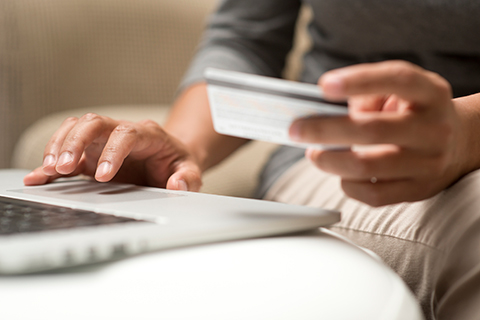First came the Internet. Then came Internet shopping. Once we all adapted to living our lives on the World Wide Web, online retailers like Amazon and Overstock emerged to fulfil our demands for instant gratification. Now, you can order anything you can think of and even have it delivered the same day.
But with great power comes great responsibility. Online shopping may have changed the way we purchase, but the risk of fraud and identity theft is greater than ever.
And that’s why it’s important to observe safe online shopping practices.
Thanks to advances in technology, our wants, needs, and desires can be purchased online from any corner of the globe. And while so many aspects of our lives have improved with the advent of Internet retailers there’s still a need to be cautious.
- Limit the information you provide
- Shop only on verified sites, look for trust symbols
- Steer clear of deals too good to be true
- Keep an eye on your statements
Be Wary of Websites
Though it may sound obvious, purchase goods and services only from a secure site. The easiest way to tell if a website is secure is by looking at its address. Websites that begin with https use data encryption to protect information—sites without the “s” don’t.
In the browser, you should see a lock icon followed by the word “Secure” indicating the site you are visiting is secure (the S in https stands for Secure). If you don’t see a lock icon the site is not secure and you should think twice about what information you enter.

Do Your Homework
Thanks to the availability of products online, researching and shopping for the best deals is easier than ever. But just because more options have become available doesn’t mean the risk for “too-good-to-be-true” offers has gone away. If anything, the Internet has increased the opportunity for scammers.
You’d be wary of a shady looking storefront with a neglected façade and lack of customers, and the same scepticism should be applied to online retailers. In fact, if you suspect an offer or price point isn’t real, do a quick google search. Many watchdog sites keep a list of ongoing scams to avoid, so if you suspect the price or product sounds too good to be true, take a second to do some research.
Protect Your Wallet
Using an online payment service, like PayPal, can add an extra layer of protection to your online shopping experience. In the event that a site you have purchased from turns out to be fraudulent, PayPal will usually refund your money. Making purchases directly through a company’s mobile app is another way to protect yourself.
If you’re set on using cards, make sure you use a credit card and never your debit card. If you make a phony purchase using a debit card, there’s no way to get your money back. But when you use your credit card, you can be reimbursed for fraudulent charges.
Stay Extra Alert on Mobile 
These days, nearly 30% of online purchases are made on mobile. Although mobile is more convenient than using a computer, phones aren’t as well-protected as your desktop. Computers have anti-malware software that phones don’t, making it easier for hackers to steal private information off phones.
It’s also easier to get tricked on mobile since URLs are shorter and most websites appear different and wonky on than their desktop counterparts anyway.
Shop Only On Your Home Wi-Fi
Another good rule? Don’t rely on public Internet connections when shopping online—this simply increases your risk of identity theft. Many public Wi-Fi connections contain little to no security and make it very easy for hackers to intercept your valuable information.
When you use public Wi-Fi, like a coffee shop or library’s Wi-Fi, your chances of getting hacked are almost doubled. Public Wi-Fi’s aren’t encrypted and typically don’t use Virtual Private Networks (VPN), leaving you more vulnerable to data breaches.
If you share your credit card information (or any private information for that matter) on a public network, it makes your information significantly more accessible—shop online only on your home’s network.
Don’t Click on Email Links
Phishing scams operate through email links. Someone opens their email with a link to a new product or seasonal sale. They’ll click on it and then purchase the product on that site—not knowing it’s an illegitimate site. From there, hackers can collect the private information you provide: your name, address, credit card information, and more.
Instead of clicking on an email link, type the name of the site in a separate browser. Even if the official site offers the same product and price as the phone site, buy it only from the company’s official website. If you’re extra worried, you can always reach out to the company either by email or by calling them, that way you know your purchase is legitimate.
Once you’ve become a customer of an online retailer you may find your email inbox flooded with discount coupons and exclusive offers. While it can be tempting to take advantage of these amazing deals, pay special attention to what these emails are asking of you.
- Be wary of unsolicited correspondences requesting information
- Never reply to an email with personal information
- Avoid clicking any links in suspicious emails
- Always navigate to the website in a separate browser window.
Watch Your Bank Account Like a Hawk
Keep an eye on your bank accounts and credit card statements after a recent online purchase. Make sure only the charges you authorized have been posted to your account. If you notice additional or duplicate chargers from a vendor, contact them immediately. Many banks offer help recovering fraudulent charges, so if something doesn’t look right, contact your bank.
For more online safety tips, check out these related articles:
Internet Safety Guide—Parental Controls

